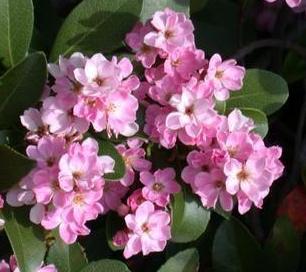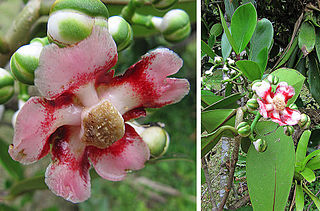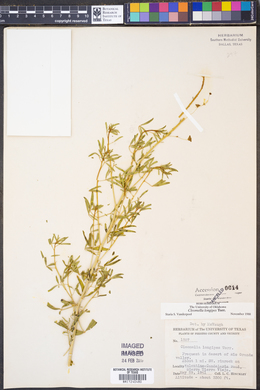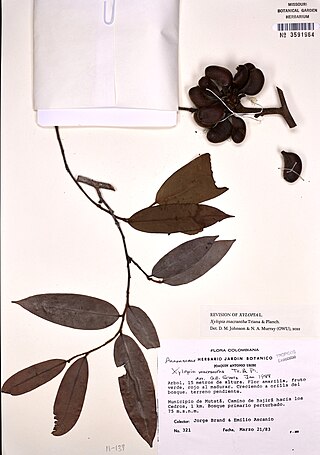
Cucumis anguria, commonly known as maroon cucumber, West Indian gherkin, maxixe, burr gherkin,cackrey, and West Indian gourd, is a vine that is indigenous to Africa, but has become naturalized in the New World, and is cultivated in many places. It is similar and related to the common cucumber (C. sativus) and its cultivars are known as gherkins.

Clethra is a genus of flowering shrubs or small trees described as a genus by Linnaeus in 1753.

Couratari is a genus of trees in the family Lecythidaceae, first described as a genus in 1775. They are native to tropical South America and Central America.

Rhaphiolepis indica, the Indian hawthorn, India hawthorn or Hong Kong hawthorn is an evergreen shrub in the family Rosaceae.

Dipteryx charapilla is a little-known species of flowering plant in the family Fabaceae, a large to mid-sized tree growing along rivers in the rainforests of Brazil. and Peru.

Clusia croatii is a species of flowering plant in the family Clusiaceae. It is found in Costa Rica and Panama, with one population in N Colombia. It is threatened by habitat loss.

Dudleya multicaulis is a succulent plant known by the common name manystem liveforever or many-stemmed dudleya. This Dudleya is endemic to southern California, where it is rare and seriously threatened as its habitat is altered by humans. Many occurrences of this species have been extirpated. This species is characterized by a few short, fingerlike cylindrical leaves with pointed tips, and its erect peduncle, which is topped with a branching inflorescence bearing up to 15 flowers on each long, thin branch. The flowers, which appear in late spring, have pointed yellow petals and long stamens. It is usually found on heavy clay or rocky soils and outcrops.
Magnolia poasana is a sub-tropical to tropical, subcanopy tree, growing in areas of montane rainforest. The names "Poas", and "poasana" originate from the Poás Volcano in Costa Rica where, along with Panama, they grow in the wild. First described by Henri François Pittier in 1910, it was later described and included in Magnolia by James Edgar Dandy (1927).
Barbieria is a genus of flowering plants in the legume family, Fabaceae. It contains a single species, Barbieria pinnata, a climber native to the tropical Americas, from southern Mexico through Central America and the Caribbean to northern South America.
Epidendrum adenoglossum is an orchid known primarily from its type herbarium specimen, Mathews 1073, collected in Peru near Pangoa. When Lindley published the name, he placed the species in the subgenus E. subg. SpathiumLindl. (1841). In 2005, Hágsater & Soto designated this species as the lectotype of E. subg. SpathiumLindl. (1841).

Pentaclethra macroloba is a large and common leguminous tree in the genus Pentaclethra native to the wet tropical areas of the northern Neotropics, which can form monocultural stands in some seasonally flooded habitats. It has giant, bipinnate leaves shaped like feathers. It uses seed dispersal by water to establish itself in new areas, having floating seeds that are left behind after the waters recede after floods or tides. It has hard timber which is not very resistant to rot in the tropics, but it can be treated, has a pretty pink-red colour when dry, and has a number of uses. Oil used in cosmetics is extracted from the large seeds. In the northern Amazon region the bark is used in herbal medicine as an antivenom, and in the Guianas the bark has been used as a fish poison. Despite their toxicity, the seeds are eaten by variegated squirrels, parrots and macaws, and serve as the nurseries of the larvae of the moth Carmenta surinamensis.
Scaphyglottis atwoodii is a species of epiphytic orchid from Costa Rica. It is known from only one location at Finca de Selva, 3 km east of Puerto Viejo de Sarapiquí.
Cissus anisophylla is a plant species known from lowland rainforests of Panamá, Colombia, Chiapas, Brazil, Perú, Costa Rica and Ecuador.

Cleomella longipes, the Chiricahua Mountain stinkweed, is a plant species native to northern Mexico and to the southwestern United States. It has been reported from Chihuahua, San Luis Potosí, trans-Pecos Texas, New Mexico Arizona. It is found on saline or alkaline flats at elevations of 500–1000 m.
Dendrobangia is a genus of flowering plants in the family Metteniusaceae. It was formerly placed in the family Cardiopteridaceae. It was described as a genus in 1896.

Poraqueiba sericea is a species of tree in the family Metteniusaceae. It is native to South America.

Chamaedorea costaricana is a species of palm in the genus Chamaedorea, found in Central America. A common local name in Costa Rica is pacaya, though this is also used as a name for Chamaedorea tepejilote.
Rhizophora harrisonii is a species of plant in the family Rhizophoraceae. It can be found in Brazil, Cameroon, Colombia, Costa Rica, Ecuador, Guyana, French Guiana, Honduras, Nicaragua, Panama, Suriname, Trinidad, Tobago, and Venezuela.
Goethalsia is a monotypic genus of flowering plants belonging to the family Malvaceae. It only contains one species, Goethalsia meiantha(Donn.Sm.) Burret It is within the Grewioideae subfamily.

Xylopia macrantha is a species of plant in the Annonaceae family. It is native to Colombia, Costa Rica and Panama. José Jerónimo Triana and Jules Émile Planchon, the botanists who first formally described the species, named it after its large flowers.













